A Comparative Analysis of Waste Biomass Pyrolysis in Py-GC-MS and Fixed-Bed Reactors
Abstract
1. Introduction
2. Materials and Methods
2.1. Materials
2.2. Proximate and Ultimate Analysis
2.3. Gas Chromatography (GC) Analysis
2.4. Pyrolysis Gas Chromatography-Mass Spectrometry (Py-GC-MS)
2.5. Fixed-Bed Pyrolysis
3. Results
3.1. Materials
3.2. Results from the Pyrolysis Gas Chromatography Mass Spectrometry (Py-GC-MS)
3.3. Distribution of Fixed-Bed Pyrolysis Products from Waste Biomass Feedstocks (CS, TW, and FW)
4. The Py-GC-MS and Fixed-Bed Pyrolysis—Discussion
5. Conclusions
Author Contributions
Funding
Data Availability Statement
Conflicts of Interest
References
- Ahorsu, R.; Medina, F.; Constantí, M. Significance and Challenges of Biomass as a Suitable Feedstock for Bioenergy and Biochemical Production: A Review. Energies 2018, 11, 3366. [Google Scholar] [CrossRef][Green Version]
- Dai, L.; Zhou, N.; Li, H.; Deng, W.; Cheng, Y.; Wang, Y.; Liu, Y.; Cobb, K.; Lei, H.; Chen, P.; et al. Recent Advances in Improving Lignocellulosic Biomass-Based Bio-Oil Production. J. Anal. Appl. Pyrolysis 2020, 149, 104845. [Google Scholar] [CrossRef]
- Barta-Rajnai, E.; Wang, L.; Sebestyén, Z.; Barta, Z.; Khalil, R.; Skreiberg, Ø.; Grønli, M.; Jakab, E.; Czégény, Z. Comparative Study on the Thermal Behavior of Untreated and Various Torrefied Bark, Stem Wood, and Stump of Norway Spruce. Appl. Energy 2017, 204, 1043–1054. [Google Scholar] [CrossRef][Green Version]
- Hupa, M.; Karlström, O.; Vainio, E. Biomass Combustion Technology Development—It Is All about Chemical Details. Proc. Combust. Inst. 2017, 36, 113–134. [Google Scholar] [CrossRef]
- Kaur, R.; Kumar, A.; Biswas, B.; Krishna, B.B.; Bhaskar, T. Investigations into Pyrolytic Behaviour of Spent Citronella Waste: Slow and Flash Pyrolysis Study. Bioresour. Technol. 2022, 366, 128202. [Google Scholar] [CrossRef] [PubMed]
- Hoang, A.T.; Ong, H.C.; Fattah, I.M.R.; Chong, C.T.; Cheng, C.K.; Sakthivel, R.; Ok, Y.S. Progress on the Lignocellulosic Biomass Pyrolysis for Biofuel Production toward Environmental Sustainability. Fuel Process. Technol. 2021, 223, 106997. [Google Scholar] [CrossRef]
- Hansen, S.; Mirkouei, A.; Diaz, L.A. A Comprehensive State-of-Technology Review for Upgrading Bio-Oil to Renewable or Blended Hydrocarbon Fuels. Renew. Sustain. Energy Rev. 2020, 118, 109548. [Google Scholar] [CrossRef]
- Hu, X.; Gholizadeh, M. Progress of the Applications of Bio-Oil. Renew. Sustain. Energy Rev. 2020, 134, 110124. [Google Scholar] [CrossRef]
- Amenaghawon, A.N.; Anyalewechi, C.L.; Okieimen, C.O.; Kusuma, H.S. Biomass Pyrolysis Technologies for Value-Added Products: A State-of-the-Art Review. Environ. Dev. Sustain. 2021, 23, 14324–14378. [Google Scholar] [CrossRef]
- Fahmy, T.Y.A.; Fahmy, Y.; Mobarak, F.; El-Sakhawy, M.; Abou-Zeid, R.E. Biomass Pyrolysis: Past, Present, and Future. Environ. Dev. Sustain. 2020, 22, 17–32. [Google Scholar] [CrossRef]
- Muzyka, R.; Misztal, E.; Hrabak, J.; Banks, S.W.; Sajdak, M. Various Biomass Pyrolysis Conditions Influence the Porosity and Pore Size Distribution of Biochar. Energy 2023, 263, 126128. [Google Scholar] [CrossRef]
- Haghighat, M.; Majidian, N.; Hallajisani, A.; samipourgiri, M. Production of Bio-Oil from Sewage Sludge: A Review on the Thermal and Catalytic Conversion by Pyrolysis. Sustain. Energy Technol. Assess. 2020, 42, 100870. [Google Scholar] [CrossRef]
- Plis, A.; Lasek, J.; Skawińska, A.; Zuwała, J. Thermochemical and Kinetic Analysis of the Pyrolysis Process in Cladophora Glomerata Algae. J. Anal. Appl. Pyrolysis 2015, 115, 166–174. [Google Scholar] [CrossRef]
- Li, G.; Ji, F.; Bai, X.; Zhou, Y.; Dong, R.; Huang, Z. Comparative Study on Thermal Cracking Characteristics and Bio-Oil Production from Different Microalgae Using Py-GC/MS. Int. J. Agric. Biol. Eng. 2019, 12, 208–213. [Google Scholar] [CrossRef]
- Grams, J. Chromatographic Analysis of Bio-Oil Formed in Fast Pyrolysis of Lignocellulosic Biomass. Rev. Anal. Chem. 2020, 39, 65–77. [Google Scholar] [CrossRef]
- Chen, D.; Wang, Y.; Liu, Y.; Cen, K.; Cao, X.; Ma, Z.; Li, Y. Comparative Study on the Pyrolysis Behaviors of Rice Straw under Different Washing Pretreatments of Water, Acid Solution, and Aqueous Phase Bio-Oil by Using TG-FTIR and Py-GC/MS. Fuel 2019, 252, 1–9. [Google Scholar] [CrossRef]
- Biswas, B.; Pandey, N.; Bisht, Y.; Singh, R.; Kumar, J.; Bhaskar, T. Pyrolysis of Agricultural Biomass Residues: Comparative Study of Corn Cob, Wheat Straw, Rice Straw and Rice Husk. Bioresour. Technol. 2017, 237, 57–63. [Google Scholar] [CrossRef]
- Muzyka, R.; Chrubasik, M.; Dudziak, M.; Ouadi, M.; Sajdak, M. Pyrolysis of Tobacco Waste: A Comparative Study between Py-GC/MS and Fixed-Bed Reactors. J. Anal. Appl. Pyrolysis 2022, 167, 105702. [Google Scholar] [CrossRef]
- Rahman, M.M.; Sarker, M.; Chai, M.; Li, C.; Liu, R.; Cai, J. Potentiality of Combined Catalyst for High Quality Bio-Oil Production from Catalytic Pyrolysis of Pinewood Using an Analytical Py-GC/MS and Fixed Bed Reactor. J. Energy Inst. 2020, 93, 1737–1746. [Google Scholar] [CrossRef]
- Edmunds, C.W.; Molina, E.A.R.; André, N.; Hamilton, C.; Park, S.; Fasina, O.; Adhikari, S.; Kelley, S.S.; Tumuluru, J.S.; Rials, T.G.; et al. Blended Feedstocks for Thermochemical Conversion: Biomass Characterization and Bio-Oil Production from Switchgrass-Pine Residues Blends. Front. Energy Res. 2018, 6, 79. [Google Scholar] [CrossRef][Green Version]
- Mariyam, S.; Alherbawi, M.; Rashid, N.; Al-Ansari, T.; McKay, G. Bio-Oil Production from Multi-Waste Biomass Co-Pyrolysis Using Analytical Py–GC/MS. Energies 2022, 15, 7409. [Google Scholar] [CrossRef]
- Landrat, M.; Abawalo, M.T.; Pikoń, K.; Turczyn, R. Bio-Oil Derived from Teff Husk via Slow Pyrolysis Process in Fixed Bed Reactor and Its Characterization. Energies 2022, 15, 9605. [Google Scholar] [CrossRef]
- Sajdak, M. Characteristics of Chars from Biomass and Waste Co-Pyrolysis. Mendeley Data 2021, 2. [Google Scholar] [CrossRef]
- Sajdak, M. Impact of Plastic Blends on the Product Yield from Co-Pyrolysis of Lignin-Rich Materials. J. Anal. Appl. Pyrolysis 2017, 124, 415–425. [Google Scholar] [CrossRef]
- Sieradzka, M.; Rajca, P.; Zajemska, M.; Mlonka-Mędrala, A.; Magdziarz, A. Prediction of Gaseous Products from Refuse Derived Fuel Pyrolysis Using Chemical Modelling Software—Ansys Chemkin-Pro. J. Clean. Prod. 2020, 248, 119277. [Google Scholar] [CrossRef]
- Mlonka-Mędrala, A.; Evangelopoulos, P.; Sieradzka, M.; Zajemska, M.; Magdziarz, A. Pyrolysis of Agricultural Waste Biomass towards Production of Gas Fuel and High-Quality Char: Experimental and Numerical Investigations. Fuel 2021, 296, 120611. [Google Scholar] [CrossRef]
- Zajemska, M.; Magdziarz, A.; Iwaszko, J.; Skrzyniarz, M.; Poskart, A. Numerical and Experimental Analysis of Pyrolysis Process of RDF Containing a High Percentage of Plastic Waste. Fuel 2022, 320, 123981. [Google Scholar] [CrossRef]
- Ugolini, M.; Recchia, L.; Guandalini, G.; Manzolini, G. Novel Methodology to Assess Advanced Biofuel Production at Regional Level: Case Study for Cereal Straw Supply Chains. Energies 2022, 15, 7197. [Google Scholar] [CrossRef]
- Zulkafli, A.H.; Hassan, H.; Ahmad, M.A.; Mohd Din, A.T.; Wasli, S.M. Co-Pyrolysis of Biomass and Waste Plastics for Production of Chemicals and Liquid Fuel: A Review on the Role of Plastics and Catalyst Types. Arab. J. Chem. 2023, 16, 104389. [Google Scholar] [CrossRef]
- Foong, S.Y.; Liew, R.K.; Lee, C.L.; Tan, W.P.; Peng, W.; Sonne, C.; Tsang, Y.F.; Lam, S.S. Strategic Hazard Mitigation of Waste Furniture Boards via Pyrolysis: Pyrolysis Behavior, Mechanisms, and Value-Added Products. J. Hazard. Mater. 2022, 421, 126774. [Google Scholar] [CrossRef]
- Chen, H.; Lin, G.; Chen, Y.; Chen, W.; Yang, H. Biomass Pyrolytic Polygeneration of Tobacco Waste: Product Characteristics and Nitrogen Transformation. Energy Fuels 2016, 30, 1579–1588. [Google Scholar] [CrossRef]
- Guo, Z.; Zhang, K.; Zhang, Q.; Fu, L.; Liu, Z.; Kong, Z.; Wang, L.; Liu, C.; Hua, L.; Li, B. Tobacco Fractionation and Its Effects on Pyrolysis Chemistry. J. Anal. Appl. Pyrolysis 2022, 167, 105650. [Google Scholar] [CrossRef]
- Dimitriadis, A.; Bergvall, N.; Johansson, A.C.; Sandström, L.; Bezergianni, S.; Tourlakidis, N.; Meca, L.; Kukula, P.; Raymakers, L. Biomass Conversion via Ablative Fast Pyrolysis and Hydroprocessing towards Refinery Integration: Industrially Relevant Scale Validation. Fuel 2023, 332, 126153. [Google Scholar] [CrossRef]
- Yıldız, Z.; Ceylan, S. Pyrolysis of Tobacco Factory Waste Biomass: TG-FTIR Analysis, Kinetic Study and Bio-Oil Characterization. J. Therm. Anal. Calorim. 2019, 136, 783–794. [Google Scholar] [CrossRef]
- Dai, Y.; Xu, J.; Zhu, L.; Jiang, J.; Zhou, Y.; Zhou, G. Mechanism Study on the Effect of Glycerol Addition on Tobacco Pyrolysis. J. Anal. Appl. Pyrolysis 2021, 157, 105183. [Google Scholar] [CrossRef]
- Ikiz, E.; Maclaren, V.W.; Alfred, E.; Sivanesan, S. Impact of COVID-19 on Household Waste Flows, Diversion and Reuse: The Case of Multi-Residential Buildings in Toronto, Canada. Resour. Conserv. Recycl. 2021, 164, 105111. [Google Scholar] [CrossRef]
- Rodgers, K.M.; Bennett, D.; Moran, R.; Knox, K.; Stoiber, T.; Gill, R.; Young, T.M.; Blum, A.; Dodson, R.E. Do Flame Retardant Concentrations Change in Dust after Older Upholstered Furniture Is Replaced? Environ. Int. 2021, 153, 106513. [Google Scholar] [CrossRef]
- Sajdak, M.; Słowik, K. Use of Plastic Waste as a Fuel in the Co-Pyrolysis of Biomass: Part II. Variance Analysis of the Co-Pyrolysis Process. J. Anal. Appl. Pyrolysis 2014, 109, 152–158. [Google Scholar] [CrossRef]
- Sajdak, M.; Muzyka, R.; Hrabak, J.; Rózycki, G. Biomass, Biochar and Hard Coal: Data Mining Application to Elemental Composition and High Heating Values Prediction. J. Anal. Appl. Pyrolysis 2013, 104, 153–160. [Google Scholar] [CrossRef]
- Sajdak, M.; Muzyka, R. Use of Plastic Waste as a Fuel in the Co-Pyrolysis of Biomass. Part I: The Effect of the Addition of Plastic Waste on the Process and Products. J. Anal. Appl. Pyrolysis 2014, 107, 267–275. [Google Scholar] [CrossRef]
- Sajdak, M.; Muzyka, R.; Hrabak, J.; Słowik, K. Use of Plastic Waste as a Fuel in the Co-Pyrolysis of Biomass: Part III: Optimisation of the Co-Pyrolysis Process. J. Anal. Appl. Pyrolysis 2015, 112, 298–305. [Google Scholar] [CrossRef]
- Odeh, A.O. Oualitative and Quantitative ATR-FTIR Analysis and Its Application to Coal Char of Different Ranks. J. Fuel Chem. Technol. 2015, 43, 129–137. [Google Scholar] [CrossRef]
- Lin, X.; Sui, S.; Tan, S.; Pittman, C.U.; Sun, J.; Zhang, Z. Fast Pyrolysis of Four Lignins from Different Isolation Processes Using Py-GC/MS. Energies 2015, 8, 5107–5121. [Google Scholar] [CrossRef][Green Version]
- Song, E.; Park, S.; Han, S.; Lee, E.; Kim, H. Characteristics of Hydrothermal Carbonization Hydrochar Derived from Cattle Manure. Energies 2022, 15, 9195. [Google Scholar] [CrossRef]
- Tsai, W.-T.; Sen, U.; Martins, M.; Santos, E.; Lemos, M.A.; Lemos, F.; Pereira, H. Slow Pyrolysis of Quercus Cerris Cork: Characterization of Biochars and Pyrolysis Volatiles. Environments 2023, 10, 4. [Google Scholar] [CrossRef]
- Ghosh, A.; Brown, R.C. Factors Influencing Cellulosic Sugar Production during Acid-Catalyzed Solvent Liquefaction in 1,4-Dioxane. ACS Sustain. Chem. Eng. 2019, 7, 18076–18084. [Google Scholar] [CrossRef][Green Version]
- Kudo, S.; Huang, X.; Asano, S.; Hayashi, J.I. Catalytic Strategies for Levoglucosenone Production by Pyrolysis of Cellulose and Lignocellulosic Biomass. Energy Fuels 2021, 35, 9809–9824. [Google Scholar] [CrossRef]
- Xu, C.; Hu, J.; Chen, Y.; Yang, Q.; Zhang, Y.; Wang, C.; Chen, K. Rapid Synthesis of Strawberry Microcapsules via Pickering Emulsion Photopolymerization for Use in Multifunctional Fabric Coatings. Prog. Org. Coat. 2021, 152, 106110. [Google Scholar] [CrossRef]
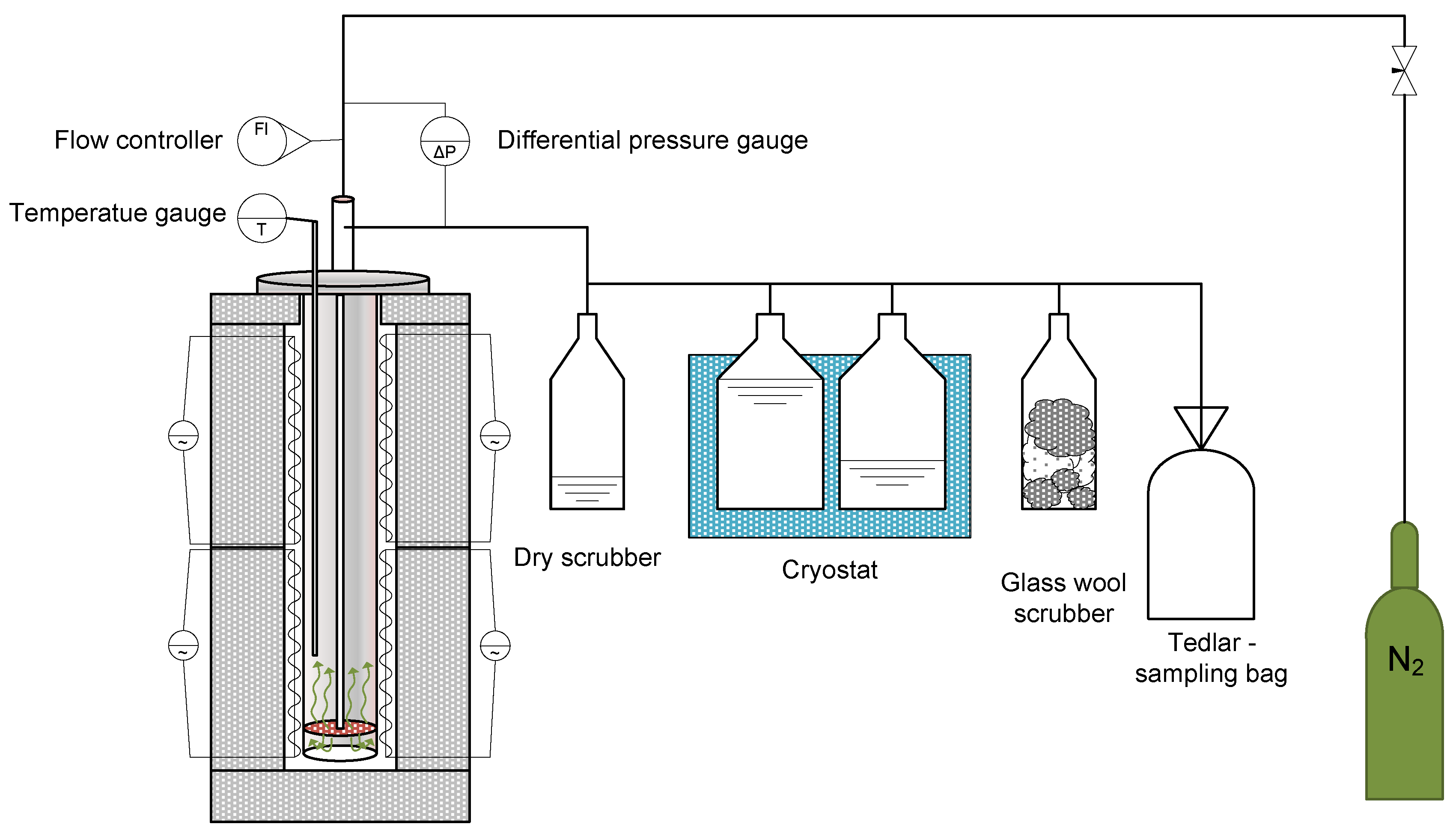
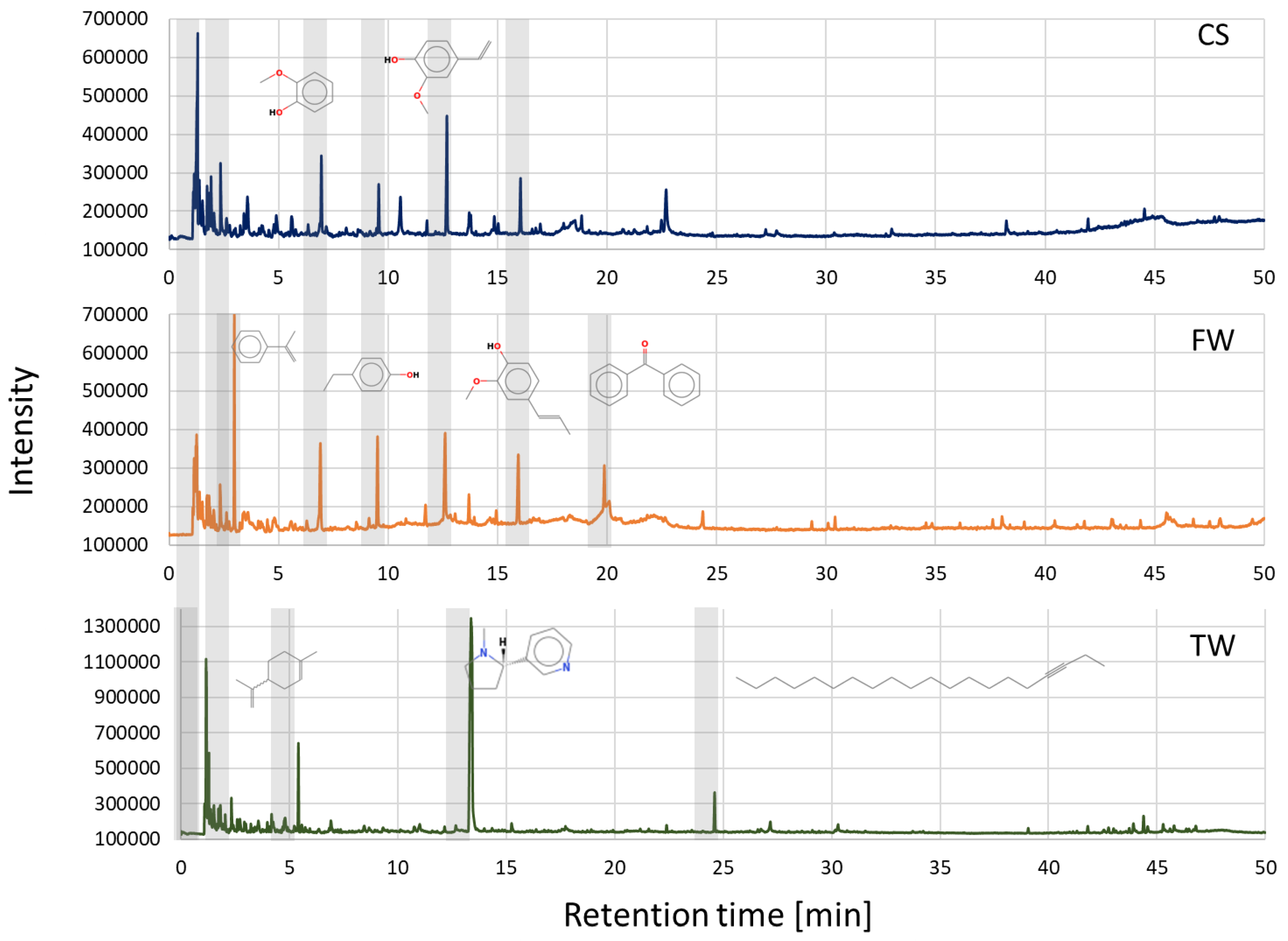


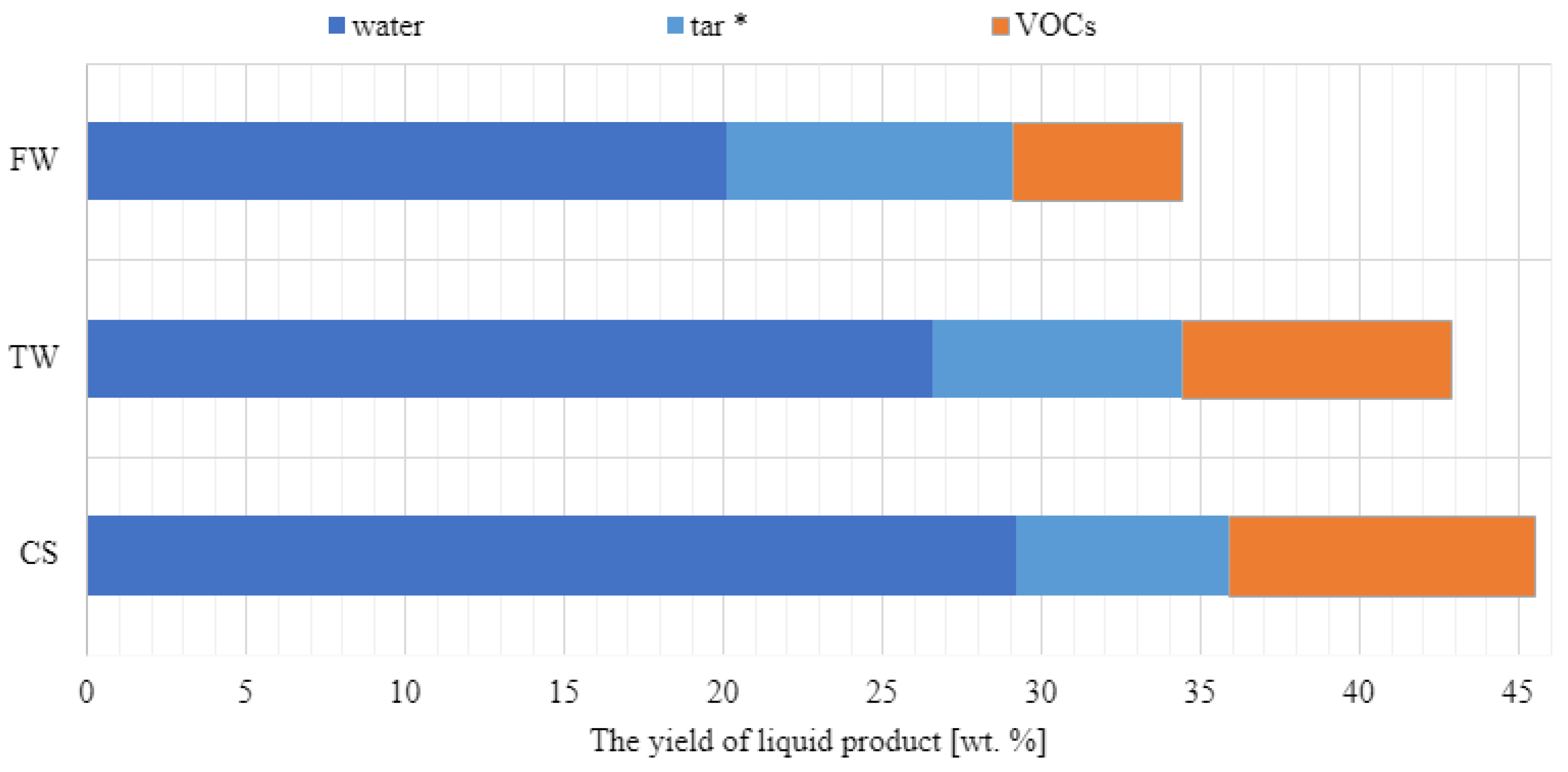
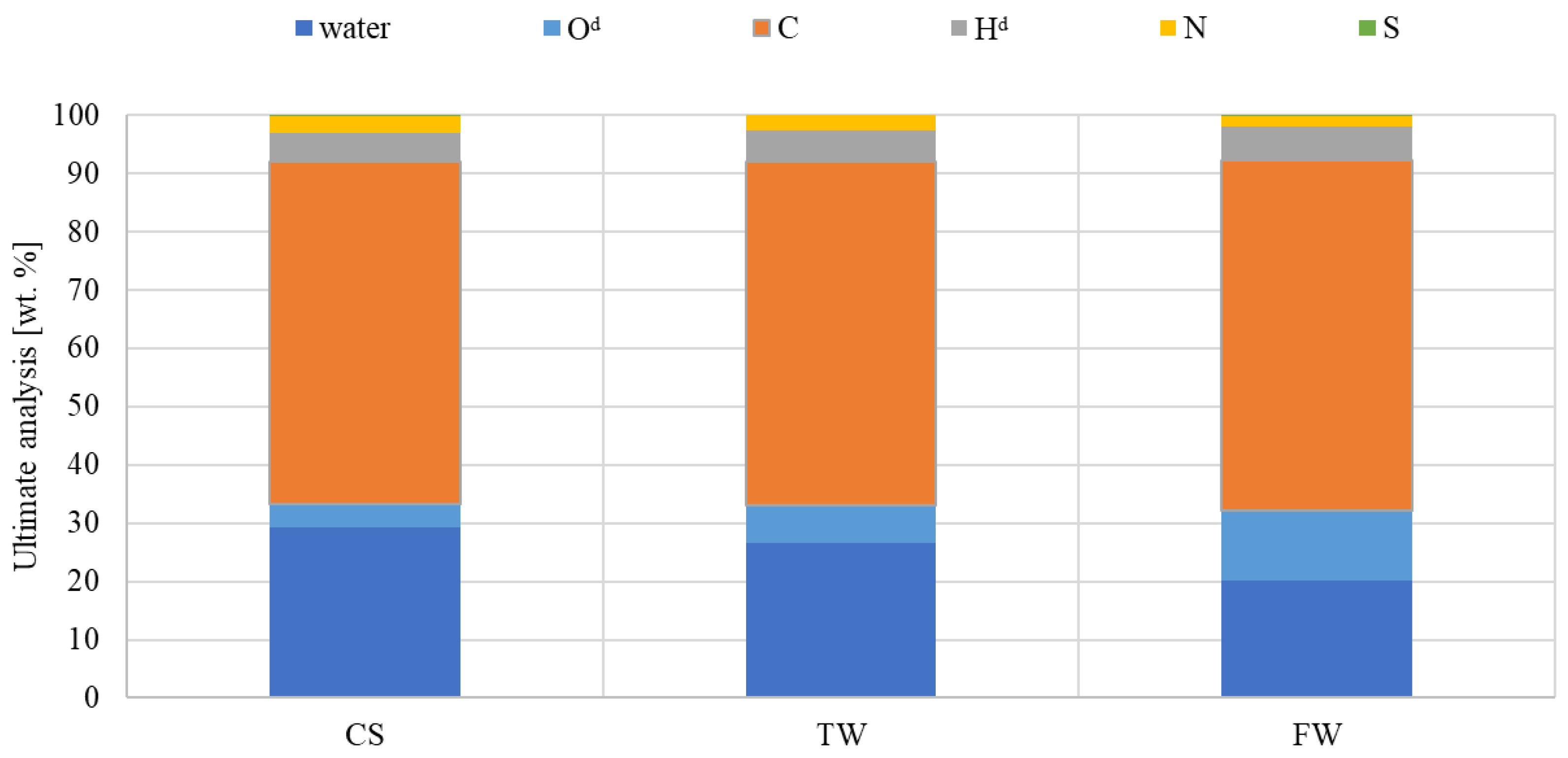
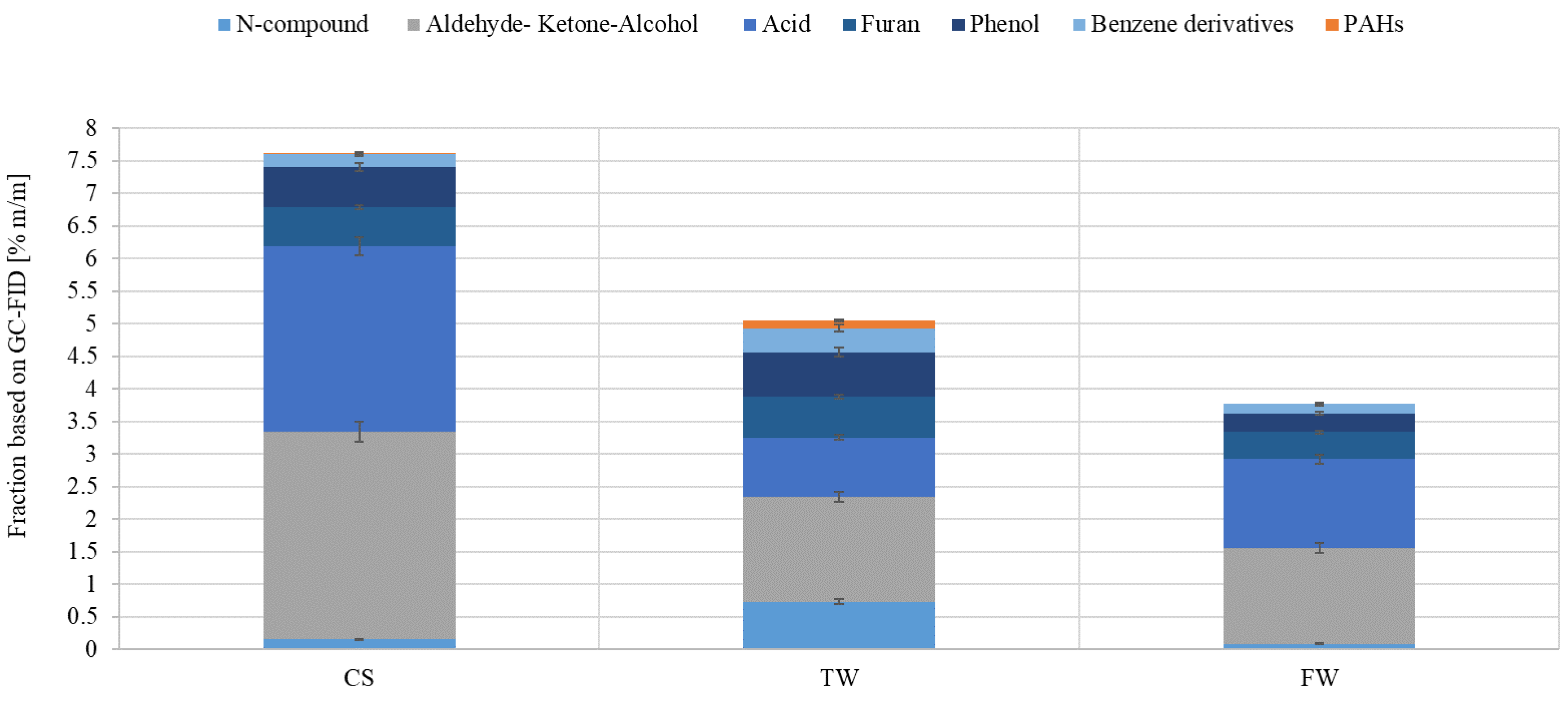


| Waste Biomass Feedstock | T, °C | Biochar, % | Bio-Oil, % | Gaseous Product, % | Ref. |
|---|---|---|---|---|---|
| Straw biomass | 400 | 54.8 | 37.5 | 7.6 | [23] |
| 450 | 38.0 | 40.4 | 21.6 | ||
| 500 | 37.6 | 39.8 | 22.6 | ||
| 550 | 32.4 | 43.0 | 24.6 | ||
| 600 | 29.3 | 47.5 | 23.2 | ||
| Tobacco waste | 300 | 49.2 | 28.7 | 22.1 | [18] |
| 400 | 38.5 | 37.3 | 24.3 | ||
| 500 | 32.2 | 43.5 | 24.3 | ||
| 600 | 29.3 | 42.9 | 27.8 | ||
| 700 | 27.9 | 40.3 | 31.8 | ||
| Furniture waste | 400 | 53.5 | 32.1 | 14.4 | [23,24] |
| 450 | 38.5 | 44.2 | 17.3 | ||
| 500 | 32.7 | 47.5 | 19.8 | ||
| 550 | 30.3 | 48.9 | 20.8 | ||
| 600 | 29.0 | 49.6 | 21.4 |
| Characteristics | CS | TW | FW | |
|---|---|---|---|---|
| Proximate analysis [%] | ||||
| Moisture | Wa | 8.3 | 11.1 | 5.8 |
| Volatile matter | VM | 71.0 | 67.2 | 78.6 |
| Fixed carbon | FC * | 16.9 | 6.9 | 11.3 |
| Ash | Aa | 3.8 | 14.8 | 4.3 |
| Ultimate analysis [%] | ||||
| Carbon | Cta | 44.0 | 41.9 | 46.3 |
| Hydrogen | Hta | 5.1 | 5.7 | 5.2 |
| Oxygen | O | 38.2 | 24.1 | 33.9 |
| Nitrogen | Na | 0.5 | 2.1 | 4.4 |
| Sulphur | Sa | 0.1 | 0.3 | 0.1 |
| Lower Heat Value [MJ/kg] | LHV | 14.7 | 13.1 | 18.5 |
| Retention Time, min | Compounds (IUPAC Name) | Area, % | ||
|---|---|---|---|---|
| CS | TW | FW | ||
| 1.09 | Nitrosomethane | 2.2 | 3.0 | 2.5 |
| 1.15 | 1,3-Pentadiene | 4.2 | 11.2 | - |
| 1.22 | 1,2-dimethylhydrazine | - | - | 3.0 |
| 1.28 | Acetic acid | 16.5 | 8.5 | 2.3 |
| 1.33 | 5-methylcyclopenta-1,3-diene | - | 1.8 | - |
| 1.36 | Pyrrolidine | - | - | 1.2 |
| 1.38 | 1-hydroxypropan-2-one | 2.8 | - | 2.5 |
| 1.55 | 2,5-dimethylfuran | 1.3 | 1.8 | 1.6 |
| 1.77 | Pyridine | 2.8 | 0.9 | 1.4 |
| 1.81 | Toluene | 0.3 | 3.0 | 2.6 |
| 1.86 | Piperidine | - | - | 1.3 |
| 1.92 | 2,3-dimethylpentane | 3.9 | - | 0.4 |
| 2.06 | 2-butyl-1-methylpyrrolidine | 1.4 | - | 2.3 |
| 2.38 | Furan-2-carbaldehyde | 4.8 | 3.0 | 3.6 |
| 2.61 | Ethylbenzene | 1.3 | 0.6 | 1.2 |
| 2.64 | Furan-2-ylmethanol | 0.6 | 1.6 | - |
| 2.98 | Prop-1-en-2-ylbenzene | 0.3 | 0.9 | 17.6 |
| 3.39 | 2H-furan-5-one | 2.6 | 0.9 | 0.5 |
| 3.64 | 2-hydroxycyclopent-2-en-1-one | 2.5 | 0.9 | 0.4 |
| 4.16 | 4-ethylpyridine | 0.6 | 2.1 | - |
| 4.23 | 5-methylfuran-2-carbaldehyde | 0.6 | 0.6 | 0.7 |
| 4.25 | 3-ethylpyridine | 0.9 | 1.0 | 0.2 |
| 4.85 | Phenol | 0.8 | 2.0 | 1.4 |
| 5.49 | 1-methyl-4-prop-1-en-2-ylcyclohexene | - | 12.0 | - |
| 5.63 | 3-methylcyclopentane-1,2-dione | 1.8 | - | 0.1 |
| 6.35 | 2-methylphenol | 0.6 | - | 0.8 |
| 6.85 | 1-(furan-2-yl)-2-hydroxyethanone | 0.6 | 0.3 | - |
| 6.99 | 2-methoxyphenol | 7.9 | 2.0 | 8.9 |
| 8.50 | Pyran-2-one | 6.7 | 0.5 | |
| 9.38 | 4-ethylphenol | 0.8 | 0.4 | |
| 10.82 | 2,3-dihydro-1-benzofuran | 1.5 | 0.6 | 0.3 |
| 11.78 | 2-methoxy-4-propylphenol | 1.2 | - | 1.3 |
| 12.72 | 4-ethenyl-2-methoxyphenol | 12.8 | 0.5 | 11.0 |
| 13.38 | 3-[(2S)-1-methylpyrrolidin-2-yl]pyridine (nicotine) | - | 21.1 | - |
| 13.77 | 2-methoxy-4-prop-2-enylphenol | 1.3 | - | 2.6 |
| 16.04 | 2-methoxy-4-[(E)-prop-1-enyl]phenol | 5.0 | - | 6.9 |
| 19.87 | Diphenylmethanone | - | - | 4.4 |
| 24.70 | Icos-3-yne | - | 6.3 | 1.8 |
| 27.25 | Hexadecanoic acid | 0.1 | 1.0 | - |
Disclaimer/Publisher’s Note: The statements, opinions and data contained in all publications are solely those of the individual author(s) and contributor(s) and not of MDPI and/or the editor(s). MDPI and/or the editor(s) disclaim responsibility for any injury to people or property resulting from any ideas, methods, instructions or products referred to in the content. |
© 2023 by the authors. Licensee MDPI, Basel, Switzerland. This article is an open access article distributed under the terms and conditions of the Creative Commons Attribution (CC BY) license (https://creativecommons.org/licenses/by/4.0/).
Share and Cite
Muzyka, R.; Sobek, S.; Dudziak, M.; Ouadi, M.; Sajdak, M. A Comparative Analysis of Waste Biomass Pyrolysis in Py-GC-MS and Fixed-Bed Reactors. Energies 2023, 16, 3528. https://doi.org/10.3390/en16083528
Muzyka R, Sobek S, Dudziak M, Ouadi M, Sajdak M. A Comparative Analysis of Waste Biomass Pyrolysis in Py-GC-MS and Fixed-Bed Reactors. Energies. 2023; 16(8):3528. https://doi.org/10.3390/en16083528
Chicago/Turabian StyleMuzyka, Roksana, Szymon Sobek, Mariusz Dudziak, Miloud Ouadi, and Marcin Sajdak. 2023. "A Comparative Analysis of Waste Biomass Pyrolysis in Py-GC-MS and Fixed-Bed Reactors" Energies 16, no. 8: 3528. https://doi.org/10.3390/en16083528
APA StyleMuzyka, R., Sobek, S., Dudziak, M., Ouadi, M., & Sajdak, M. (2023). A Comparative Analysis of Waste Biomass Pyrolysis in Py-GC-MS and Fixed-Bed Reactors. Energies, 16(8), 3528. https://doi.org/10.3390/en16083528








